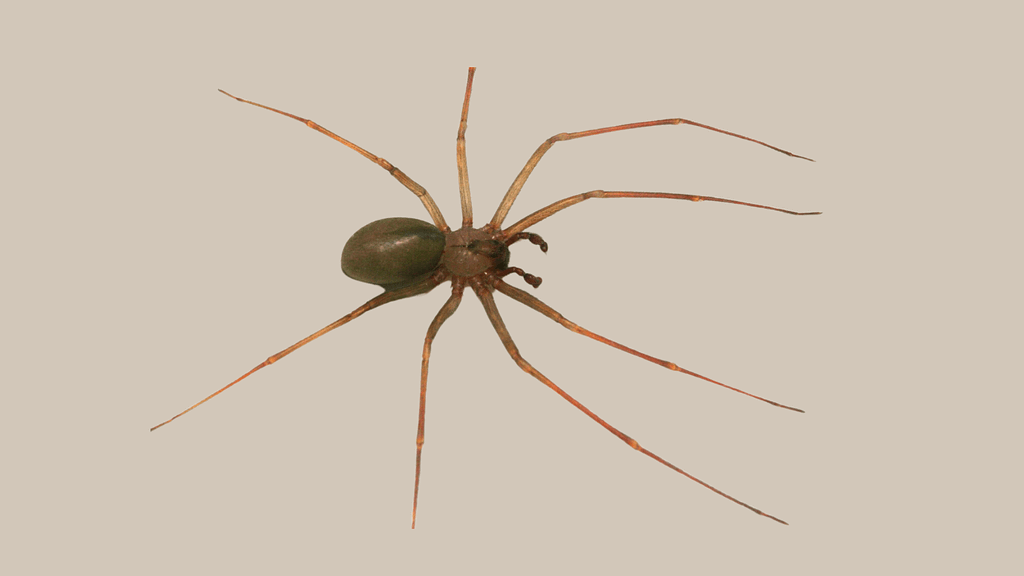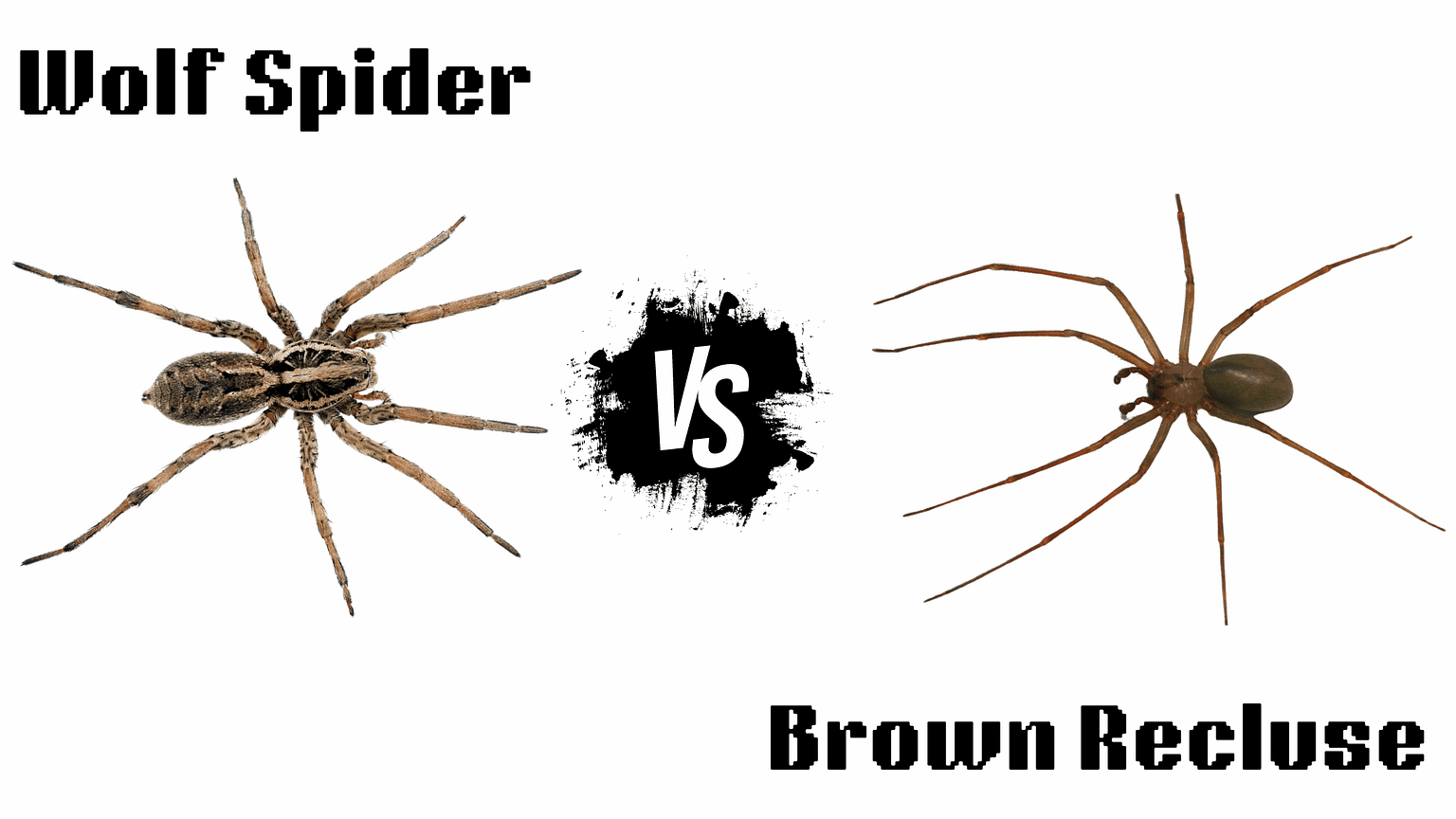Have you ever wondered why spiders have eight eyes? It’s all about watching for dinner (and maybe you, if you get too close!). But fear not; most spiders are more interested in catching insects than your ankles.
Can you differentiate between the two common brown spider breeds, the wolf spider and the brown recluse? It’s imperative to learn how to identify them as their bites can have varied effects on our health.
While the wolf spider’s bite may only cause minor discomfort, the brown recluse’s venom can be downright menacing. So, let’s dive in and discover how to differentiate these fuzzy creatures and become spider experts! Before we start, You Can Read Grass Spider vs. Wolf Spider: 25 Differences and Similarities.
Spider Showdown: Wolf Spider vs. Brown Recluse

Spiders are truly fascinating creatures in the world of arachnids, and the Wolf Spider and the Brown Recluse are widely recognized as some of the most intriguing spider species. They possess unique and distinct characteristics and behaviors that distinguish them from other spiders.
It is interesting to observe how two of these spiders interact in a spider showdown, where they come face-to-face. The Wolf Spider, known for its ferocity, is one of the most enormous spiders in the United States.
On the other hand, the Brown Recluse is known to be one of the most venomous spiders in the world. Who would come out on top in a battle between these two spiders?
Looks Can Be Deceiving: Appearance Breakdown
Are you ready to learn about the fierce and glamorous world of spiders? These eight-legged creatures can leave even the bravest of us spooked. But did you know that not all spiders are created equal?
Some, like the wolf spider and the brown recluse, may look alike, but they have distinct differences that are crucial to understanding. Don’t let fear get the best of you!
Eyes: Hunters with a Keen Gaze vs. Shy Eyes
Wolf spiders are characterized by their eyes. They possess a unique set of eight eyes arranged in three rows, distinguishing them from other spider species. In the spider world, they are known as the eight-eyed detectives.
One of the most distinctive traits of these creatures is the notable pair of large eyes situated in the front. Their eyesight is exceptionally sharp, enabling them to hunt prey rapidly. It’s almost like having a pair of miniature binoculars attached to their face.
The brown recluse spider likes to live alone. It has six small eyes grouped into three pairs near the front of its head. Because its eyesight could be better, the spider relies more on touch and vibrations to sense its surroundings.
Body Markings of Brown Recluses and Wolf Spiders
Body markings are critical to identifying spiders, particularly the brown recluse and wolf spiders in North America. The brown recluse has a violin-shaped marking on its brown body, while the wolf spider has stripes or spots on its gray or brown body. Knowing these markings can help you identify these spiders and take necessary action, such as contacting a pest control service for safe removal.

Brown Recluse:
Violin-Shaped Marking: The most defining feature of a Brown Recluse is the dark brown violin marking on its back, near the head (cephalothorax). This marking has the “neck” of the violin pointing towards the spider’s rear, which is why they’re also called fiddleback spiders.
Color Variations: Brown Recluses are typically light to dark brown, though they can have some variations with grays and blacks mixed in. Their overall coloring tends to be uniform, aside from the violin marking.
Wolf Spider:
Color Variations: Wolf spiders come in a broader range of colors than Brown Recluses. They primarily stick to neutral tones like brown, gray, and black, but these can be mixed and matched in various patterns for camouflage.
Striped Patterns: Many Wolf Spider species have striped patterns on their bodies. The stripes can go up and down, side to side, or even at an angle. They can be thick or thin and have different colors, all in those neutral tones we discussed.
Critical Differences in Markings:
Number of Eyes: Brown Recluses have six eyes arranged uniquely, while Wolf Spiders have eight more enormous eyes.
Overall Markings: Brown Recluses are uniform in color with distinct violin markings. Wolf Spiders have various color combinations and patterns, often including stripes.
Size Difference Between Brown Recluses and Wolf Spider
Regarding Brown Recluses and Wolf Spiders, it’s important to note a notable disparity in their physical size. To make it simpler for comparison purposes, let me provide you with a detailed breakdown of their respective dimensions.
Brown Recluse:
- Body Size: These spiders are pretty small. Their body length (cephalothorax) is typically only around ¼ inch (6.4 mm) to ¾ inch (19 mm).
- Leg Span: Even with their legs extended, Brown Recluses remain relatively small, with a leg span reaching a maximum of around 1 inch (2.5 cm). They’re roughly the size of a nickel or a quarter.
Wolf Spider:
- Body Size: Wolf Spiders are considerably more giant than Brown Recluses. Depending on the species, their body length can range from ½ inches (12.7 mm) to 1 ¼ inches (32 mm).
- Leg Span: The size difference becomes even more apparent with leg span. Wolf Spiders can have a leg span of 1 inch (2.5 cm) to 3 inches (7.6 cm), with some even reaching up to 4 inches (10 cm).
Visualizing the Size Difference:
Imagine placing a Brown Recluse on a US penny. The spider’s body would fit within the penny’s diameter, with the legs extending slightly over the edge. In contrast, depending on the species and size, a Wolf Spider could cover most of the penny with its body and have legs that reach well beyond the coin’s diameter.
Where Might You Find Them? Habitat Preferences
Knowing where Brown Recluses and Wolf Spiders prefer to live can be very helpful in avoiding encounters with them. By understanding their preferred habitats, you can take steps to prevent them and reduce the risk of potentially harmful interactions.
Wolf Spiders:
Habitat: Wolf spiders are fond of environments that offer them reasonable hunting grounds and some protection. They’re commonly found in Gardens.
- Fields
- Around buildings (especially on the exterior)
Active Hunters: Wolf Spiders are active hunters. They rely on their excellent eyesight and agility to chase down their prey, including insects, other spiders, and even small invertebrates, rather than spinning webs to trap them.
Brown Recluse:
Habitat: Brown Recluses prefer dry, undisturbed areas to hide and avoid contact. They are more likely to be found in Closets.
- Basements
- Attics
- Crawl spaces
- Behind furniture or boxes
Climate Preference: Brown Recluses are more prevalent in warmer climates and are most commonly found in the southern and midwestern United States. Their range stretches from central Texas to western Georgia and north to Kentucky.
Brown Recluses, a type of spider, has not been found in California or beyond its natural habitat. Although some spider species in California share similarities with Brown Recluses, these spiders rarely come into contact with humans as their habitats do not usually overlap with human settlements.
Bite! Should You Be Worried?
Are you worried or concerned about being bitten by something or someone? You may have had a recent encounter with a creature that has left you feeling uneasy, or you may be interested in learning more about the potential risks and dangers of bites. Whatever your specific situation, you must be informed and prepared to stay safe and healthy.
Wolf Spider:
Mild Venom: Unlike Brown Recluses, Wolf Spiders have mild venom, similar to a bee sting. Their bite is more of a nuisance than a serious medical threat.
Typical Reaction: If bitten by a Wolf Spider, you might experience localized swelling, redness, and possibly some itching at the bite site. These symptoms typically subside within a few hours or days.
Non-Aggressive: Wolf Spiders are not aggressive and usually only bite if threatened or cornered.
Brown Recluse:
Necrotic Venom: Brown Recluse bites are more concerning due to their necrotic venom, which can destroy tissue around the bite wound.
Symptoms to Watch For: A Brown Recluse bite might not be immediately painful, but symptoms can develop within a few hours. Look for Initial redness at the bite site.
- A pale area developed in the center of the redness
- A bulls-eye pattern forms around the bite (red outer ring with a pale center)
- Later progression to a blister or open sore (ulcer)
Seek Medical Attention: If you suspect a Brown Recluse bite, it’s crucial to seek medical attention promptly. Early diagnosis and treatment can help minimize tissue damage and potential complications.
Beyond the Bite: Benefits and Concerns
Wolf Spiders:
Natural Pest Control: While their bite can be a minor annoyance, Wolf Spiders are beneficial. They act as natural pest control by preying on insects like crickets, roaches, and other spiders. This can help keep unwanted bugs in your garden or your check home.
Brown Recluse:
Preventative Measures: Brown Recluses, while not inherently aggressive, can cause serious health problems with their bite. The best approach is to take preventative measures to avoid infestations in the first place.
Here are some critical steps:
- Reduce Clutter: Eliminate clutter in potential hiding spots like attics, basements, closets, and behind furniture. This reduces the areas where Brown Recluses can build webs and take shelter.
- Seal Entry Points: Seal cracks and gaps around windows, doors, foundations, and utility lines to help prevent Brown Recluses from entering your home.
Conclusion
The article provides valuable insights into the characteristics and distinguishing features of two commonly found brown spiders in North America – the wolf spider and the brown recluse spider. While the bite of a wolf spider may only result in mild discomfort, the venom of a brown recluse spider can seriously threaten human health.
The article provides useful tips on distinguishing between different types of spiders based on their physical characteristics, such as appearance, eye arrangement, body markings, and size. Additionally, it provides insightful information on these fascinating creatures’ unique traits.






